Inquiries about the Castle and Rampant Lion Cuartillas
by Pablo Luna Herrerabased on his website (in Spanish)
The purpose of this article is to shed light of one of the tiniest coins struck by the Mexican Mint: the castle and rampant lion cuartillos (quarters), minted from 1796 to 1816 in Mexico, but also in many mints in South America. The following text will address two issues, the trouble of the denomination per se, and the controversies between the legislation to produce these coins and the actions that the mint actually took. In addition, starting from the fact that in Mexico the production of these pieces and its implementation was not only problematic, both for society and for the authorities, but also late, in comparison with other Latin American countries, I will also cover the background to producing this denomination, its end in the context of the Mexican insurgent movement, and the technical production in the minting process.
The quarters: a denomination not wanted by anyone.
The “small currency (moneda menuda)” or “simple currency (moneda sencilla)” issued by the government authority was always the great shortcoming in the regional economy, even beyond the colonial regime. Retail trade functions badly without low denomination currency, affecting the economy as a consequence. The first cuartillos struck in Mexico have their roots in the Charles and Johanna series, but for different reasons (that will be explained in a moment) the value was not a success and was withdrawn from circulation and not minted anymore for centuries.
So, why were the cuartillas and the copper coinage removed from circulation for centuries? And why did Mexico take so long to implement this denomination (unlike Peru, which did it more easily)? As regards the copper coinage, various authors agree that the first issues in the Charles and Johanna period were disliked by the indigenous people, due to their low value, being unused and despised, even thrown into rivers. As for the ¼ real silver coin, this was initially due to monetary changes in Spain, where the silver cuartilla was exchanged for vellon rico (lowgrade silver), and this denomination was then discontinued after it was counterfeited in great quantity. In spite of these facts the orders to mint such a coin were not required in the overseas territories. Eventually the territory of Peru managed to implement the cuartilla. For Mexico, centuries would have to pass for its authorization.
Ruggiero Romano in his excellent work Moneda, seudomonedas y circulación monetaria en las economías de MéxicoRuggiero Romano, Moneda, seudomonedas y circulación monetaria en las economías de México, Fondo de Cultura Económica, Mexico D.F., 1998 asserts that there was an economic political will by the “powerful classes” that led all of Hispanic America to eliminate the small currency of silver and/or copper.
On 6 March 1550 the City Council of Mexico City asked Viceroy Mendoza to give the order to stop the manufacture of these coins since it caused pride, greed and laziness in the indigenous people, who had stopped working the land and exercising their trades, causing a lack of food produced through agriculture, and called for order for the prosperity of the city. This reflected that if the Indians were to be kept under control as a force of production, they would have to be excluded from the monetary economy, and the only access to monetization was the small currency. It was a danger for the Spanish if the Indian became an autonomous economic agent, some more conservatives even asked that the Indian not be allowed to use the silver coinage, that they did not leave the natural economy, cocoa, blankets and others devices, which would lose their supplementary value as a medium of exchange with the small currency.
The above really aimed for the Spanish to maintain political, economic and social control over the aboriginal population: such an ideal would last for more than 300 years.
Throughout the eighteenth century the coinage of the half real (the smallest of all denominations) in the Mexican Mint did not exceed 2% of all denominations. From 1788 to 1792, 140,600 pesos were minted in half-real currency, at 28,120 pieces per year, on average during that five-year period the Mint minted 20,000,000 pesos, in such a way that in that period of everything minted what was destined for the half-real currency represented just 0.14% per year of all coined .
The shortage of currency in New Spain favored the merchants of Mexico who controlled the local silver, by allowing them to carry out very profitable exchanges. With the purpose of avoiding the dispersal of the precious metal, they promoted the use of bills of exchange (letras de cambio) or loans (libranzas) and cash books, as well as the use of cocoa as a medium of exchange in small transactions.
The cuartillas in the twilight of Mexican colonial life.
Of all the quarters in the colonial age the only denomination to endure was this, although with complications. Everything originated with the Royal Order of 30 April 1789, during the reign of Charles IV, which authorized the minting of ¼ real coins. However, this order would not be published in Mexico until 1794.
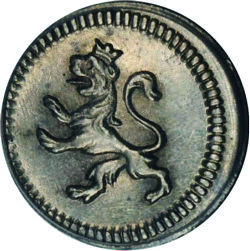
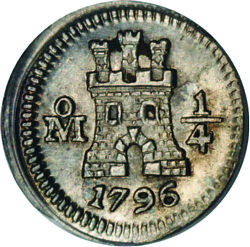
1/4 Real, Mexico, Carlos IV, 1796, 12 mm.
Stack’s Bowers & Ponterio, November 2013 Baltimore Auction. Lot 23414, sold for $240.
On 3 March 1794 the Count of Revillagigedo mentioned that people had long desired the ¼ real denomination: he also added that the small currency has greater influence on the internal trade of the kingdom, which could not operate without it, and thus not having made copper coins in these domains, it was necessary for the shopkeepers to have invented and produced in their own way and in different materials certain kinds of “tlacos”. The new denomination would come to provide relief for the excessive changes in value of these popular currencies.
It should be noted that after the Royal Order of 18 August 1790, King Charles IV requested information from the officials of the mints on the advisability of minting copper coins, given the need for small coins: the opinion was generally adverse, although the recommendation to manufacture ¼ real coins was reaffirmed, as had been planned since 1789.
Regarding the delay in initiating the minting, it was on 16 April 1793 when the Mint informed the Prosecutor of the Royal Treasury (Fiscal de la Real Hacienda) (upon request) that, at that time, cuartillas had not yet been minted in Mexico since “such an edict (the one from 1789) had not been found”, however, based on what was actually written, it may be that the real reason to delay the minting of these coins as much as possible had been due to the low profitability that there would be for some wealthy and powerful groups.
There is documentation that relates that the issue of these coins would cause poverty and misery, inconvenience and damage, for the following reasons:
• Alms to the poor and to the Church, which was ½ real for low-income people, would become less with coins of lower value.
• Petty trade would be affected by usurers giving different classes of low value coins.
• There is already enough small currency, with the ½ real coin.
• The technical difficulty in minting coins of such small diameters, as well as the high cost of manufacture.
All of the above arguments are false in practice, perhaps with the exception of the last one.
Coins were not minted in Mexico until 1796, although the documentation of the time indicates that by 1794 dies, masters and proofs struck in tin had already been sent to the Mexican mint.
It is relevant to mention that other mints quickly complied with the Royal Cedula of 1789, - Chile in 1790, Lima in 1792, and Guatemala in 1793, which in its first year had a circulation of 315,000 pieces.
The issue of this series of coins prevailed in two different reigns, Charles IV - 1796 to 1808 and Ferdinand VII – 1808 to 1816 (an 1811 trial strike in copper is known, as well as patterns for the change in design of 1772 that Spain sent to overseas mints without mintmark, denomination or assayer, being uniface brass models, the work of engraver Tomás Francisco Prieto, although the ¼ real denomination is the only one unconfirmed).
Did Mexico mint this kind of currency before 1796?

1/4 Real, Mexico, Fernando VII, 1816, 12mm.
Aureo & Calico auction, Abril 2015 lot 275, sold for $140.
On 12 February 1793, by the Royal Order of Aranjuez, three boxes of dies were sent, with the master dies and punches of two castles and two lions and their engravings and two examples in silver and eight in tin, all corresponding to the new currency of cuartillo ordered to be struck in the domains by the order of 30 April 1789.
On 2 April 1794, a “Note of the remitted amounts” on the cuartilla currency mentions there being only 960 pesos in the territory, 30,720 pieces, divided between Veracruz, Puebla, Valladolid, Guanajuato and Zacatecas. This suggest they could have been minted even in 1794 and 1795 (up to that date the first documented year is 1796).
The only certainty to date is that the mints that produced anepigraphic quarters (without mint or denomination) have been identified as the mints from Nuevo Reino (Colombia), Santiago de Chile, Guatemala and Potosí (Bolivia). The Chilean mint minted this coin from 1792 and Santa Fé de Nuevo Reino (Colombia) was the first to manufacture them.
Regarding these mints, how do you identify the mint of a small coin when it lacks a year and mintmark? There are two ways:
Firstly, by the logical coincidence in the punches (castle and lion) of the ¼ real with the other circulating currency of the period, as the following image demonstrates.
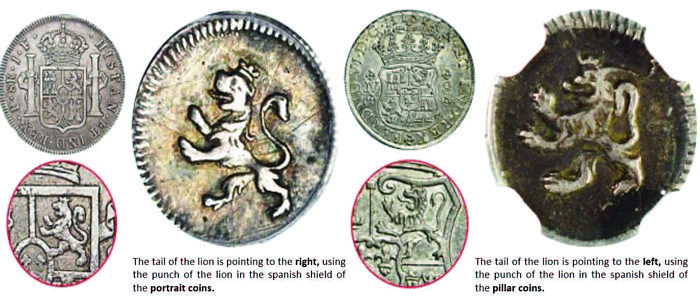
There are also other distinctive characteristics for a mint, for example Guatemala coined cuartillas without a cordoncillo edge, as did Potosí (Bolivia), the imprint of the castle in the mint of Santiago (Chile) is “small or thin castle” and “big or thick castle” (the traditional one).
Secondly, from the legislation, announcements, edicts or ordinances: an example of this is the decree of 20 January 1794 and of 30 August 1795, issued by the Viceroy Pedro Melo, in which mention is made of the epigraphs of the mint from Potosí in Bolivia.
In numismatic auctions it has been pointed out that the cuartilla without mintmarks were originally made in such a fashion as to circulate freely throughout the Spanish Colonial Empire in the Americas.
Now, regarding the evidence of the production of small currency in Mexico before 1796, some authors mention the following theories regarding the probable and missing coins of that biennium (1794-1795):
Hypothesis 1: There are dated pieces (in Mexico from 1796 to 1816), and undated pieces, so these coins may have been produced in 1794 and 1795 in Mexico, prior to the time when in August 1795 a Royal Decree was published to avoid counterfeiting of the currency (prevalent in the Kingdom of Guatemala) which ordered new security measures to be added, regarding certainty in the weight of the coin, to add the mint, year and value, without the need for new master dies, in all mints.
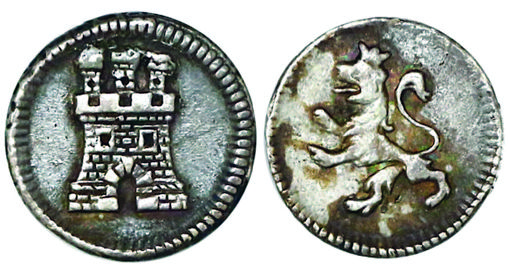
1/4 Real, Bogota, Colombia, (1770 - 1796).
Daniel Frank Sedwick, LLC, Treasure Auction 26,1-2 Nov 2019. Lot 780, sold for $240.
Hypothesis 2: MuñozMiguel L. Muñoz, "Las cuartillas de plata virreinales", in Antología Numismática Mexicana, D.F. 1967 quotes Alberto F. Pradeau as the first to suggest the “Philippine theory” (although criticized for not mentioning its source). This theory would continue to be asserted in the following decades, fueled in part by the fact that the Philippines requested money from the Mexican Mint in 1769 and 1770 (decades before these cuartillas). These coins may actually have been minted in Colombia (although they were requested of Mexico), by the communication of 16 December 1769 requesting 6,000 pesos or 192,000 pieces. There is a theory that these coins without date or mintmark were minted in Mexico for the Philippines, although this could contradict the order of 30 April 1789, prohibiting the extraction of low-denomination currency from America, although perhaps the coins alleged to have been sent to the Philippines were considered as an official remittance to another kingdom. Even so, as in the previous approach, the undated coins (and perhaps the subsequent ones as the issues destined for another Spanish territory continued) have been assigned to the years of 1794 and 1795.
Although some authors disbelieve these two hypotheses due to a lack of solid documentation in Latin American numismatics, mints have been assigned to these undated cuartillas due to opinions that are largely accepted, although without foundation, an example being the cuartillas attributed to the mint of La Rioja (Argentina). Is Mexico in the same situation?
Although it is true that Spain wanted the Mexico Mint to mint this small coin from 1794, and that the Mint did not send information about this two years later, the evidence of circulation of ¼ real coin before 1796 probably refers to trade, with undated cuartillas from other Latin American mints able to circulate in the lands of New Spain. Additionally, in terms of the legislation, the decrees that mention their production are reaffirmed with a new one in the same sense a few months later. Why confirm an order already enacted? It seems to be because the order had not been executed. If they were minted in Mexico before 1796 it will have been for a very short and unlikely period.
The end of the cuartillas in Mexico.
In Mexico the minting of this small coin ceased in 1816. In other territories it lasted until the second decade of the nineteenth century, such as Guatemala in 1822. These small coins with a diameter of 12mm, a weight of 0.81 to 0.84 grams in silver of ley 0.896 faced several factors to mark their end:
• The insurgency movement started in Mexico in 1810.
• For 1796 the Mexican Mint had minted 24,346,033 pesos in silver: for 1816 that amount had been reduced to 8,315,616 pesos, due to the opening of the Mint in the interior of New Spain, as well as the problem of transporting silver on the already dangerous roads to the metropolis.
• On 23 August 1814 Viceroy Calleja - without having consulted Madrid and on his own initiative - ordered the manufacture of copper coin to avoid the usury and ruinous result of the arbitrary coins commonly called tlacos. This sought to fight against a unloved medium of exchange and to establish a currency that assured all the classes of the state the interests of the domestic economy. The copper coin replaced the cuartilla. In 1814, 103,555 pesos were minted in copper, and similar production would continue, to a lesser extent, in 1815, 1816 and 1821.
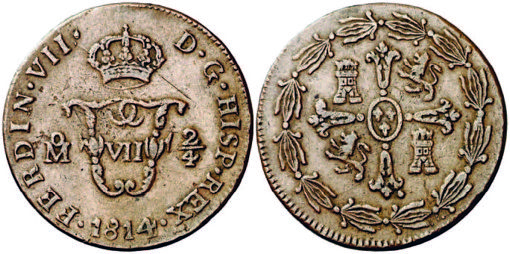
2/4 de Tlaco (1/4 Real), Fernando VII, 1814, 11mm
Aureo & Calicó S.L. Auction 295 - Floor Auction 5 Jul 2017
• Particularly in the last years of the eighteenth century., merchants sabotaged the coins when they did not accept them, or if they did, they no longer gave the customer change (pilon). At the time of making transactions with fractions for which there was no currency, which is usurious, people argued that the loss of this supposed benefit was down to the cuartillas. Additionally, the existing ¼ real tlacos were removed from circulation. This affected the shopkeeper since he gave out his coin for ¼ real but received it at 1/8 or less: with the quarters this practice would disappear.
In conclusion, the cuartillos were a denomination that did not take root in Mexican society. It is a fact that low value coins were needed, but for all the facts I have explained they did not flourish. On the other hand, the “lion and castle coinage” collided with a mint and a government that tried to postpone its use. Therefore, even though the legislation and other documents suggest that the Mexican mint might have struck quarters since 1794, in more than two hundred years no specimen has emerged.
For more information consult Chapter VI, page 203 to 235, Chapter VI, of La casa de moneda en México bajo la administración borbónica 1733-1821, by Victor Manuel Soria Murillo, available on the USMexNA online library.
